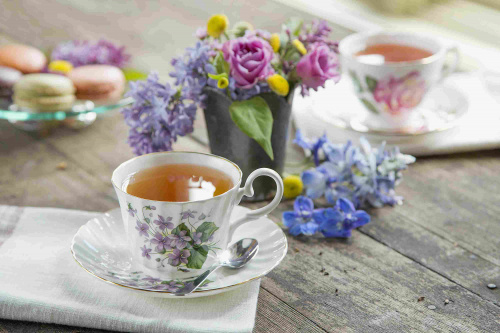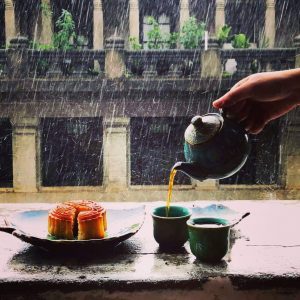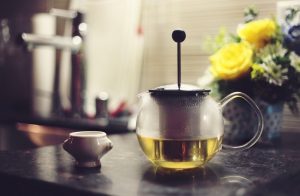
Taking a look at Tea
Camellia sinensis, these two words, the botanical name, means nothing to most people, unless they are familiar with camellia flowers or are aware that “sinensis” means “Chinese.” Tell anyone, however, that Camellia sinensis is the plant that produces tea, “tea sinensis,” and a knowing smile will his face will certainly evoke pleasant memories. Just what is it that has made the drinking of tea so enduring for thousands of years?
“You can taste and feel but not describe the exquisite state of repose produced by tea, that precious drink which drives away the five causes of sorrow.”
Camellia sinensis, that evergreen shrub which is the source of much pleasure and enjoyment, can grow as tall as 30 feet. Regular pruning every three years keep the shrubs to the desired height. All teas marketed come from this plant, but the types of tea, as varied as people’s personalities, depend on several other factors, as is explained further on. The quality of tea depends on stringent cultivation, just as people’s character becomes nobler and more precious through proper cultivation.
Ancient Chinese stories relate that formerly only highly moral, virgin women were chosen to harvest tea. It might be somewhat difficult to find enough young women of such caliber nowadays, but I think the demeanor of the tea harvester affects the quality of the gathered leaves.
Tea flourishes at elevations of up to 6,000 feet. Tea planters claim the lower the elevation, the tougher the leaves of the bush. Connoisseurs insist that teas grown at high altitudes have the most desirable flavors. Teas grown at such heights are also costlier than those from lower fields because the terrain makes them more labor-intensive.
Melted snow for tea water is again the topic in another story, that of an anonymous writer from the 16th Century. In his novel Ching Ping Mei, Moon Lady, a character in the story, goes into the snow-covered courtyard, sweeps a portion of snow from the path and heats it in the tea kettle. To brew her tea, she uses a special tea blend, “noble Phoenix and mild Lark’s tongue.” The brew enraptures the guests, compelling one of them to pen this poem in gratitude:
‘In the jasper crock
Light puffs of crystalline vapor,
From the golden bowls
A wild, rare fragrance mounds.”
Those “golden” bowls may have been poetic license, or the term could have referred to the glaze on the teacup, because no Chinese person would drink tea from a metal cup, unless in dire circumstances. The earliest teacups were pottery and later porcelain, around which a whole industry developed. The wealthy could afford the finest porcelains from the choicest manufacture, adorned with exquisite glazes and delicate designs. But other materials for teacups have also been used, as I gleaned from a passage in the famous 18th Century novel Dream of the Red Chamber, by Ts’ao Hsueh-Chi’n, where we are regaled about a nun offering tea to guests:
“The matriarch asked her what it was and the nun answered that it was rainwater saved from the year before… The nun then took Precious Virtue and Black Jade into another room and made a special tea for them. She poured the tea into two different cups… of the rare Sung period. Her own cup was of white jade.”
Several dynasties were renowned for their porcelain, but none more so than the Ming Dynasty. Teacups from that era were and are still highly prized. Some survive as rare museum pieces, unequalled in workmanship, glazes and shape.
But back to the plant that fostered such a profusion of teacup manufacture, many of them imitated to this day. Tea is indigenous to China, although 30 other countries also grow tea. The most recognized are India, Japan, Taiwan, East Africa, Russia and the former Ceylon, now called Sri Lanka. India is the largest exporter of her tea crop; China exports tea to a lesser degree. My years of tea consumption have found that the flavor of good Chinese/Taiwanese tea is superior to teas grown elsewhere. What accounts for these variants?
The answer is the soil, proper moisture at the correct time and the methods of wilting, harvesting, curing, drying, fermenting, blending and sorting the leaves into the marketable product. China teas come primarily from five provinces, Yunnan being the originator of the choicest teas because of the province’s proximity to the Himalayas. I think that Yunnan tea is one of the world’s greatest teas. Picked at high altitudes, it is free of astringency and full of rich flavor. It is expensive, but a scant spoon full of tealeaves brews a nice pot. The four other tea producing provinces, located in Eastern China, are Anhui, known for her black Keemun tea, said to have an almost chocolaty aftertaste; Fujian and Jiangxi (black teas, used primarily in tea blends) and the province of Zhejiang, reputed for its gunpowder teas, a green variety. The leaves are rolled to look like tiny gun pellets, hence the name.
All teas are harvested from the same plant, Camellia sinensis. The differences arise from the types of the harvested tealeaves themselves and their processes of withering, drying, oxidizing/fermenting, smoking, roasting and packing. The choicest and most expensive teas are prepared from the first three leaves, including the unripe tip at the top of the plant, harvested at exactly the right time. Lesser qualities are from the next two leaves down on the branch. Three main types of tea are available – non-fermented green tea, black tea, fermented and Oolong (meaning Black Dragon), a semi-fermented tea, manufactured mainly in Taiwan. That gives a fairly accurate description how Chinese oolong teas are prepared for consumption, the different examples of oolong, what accounts for the myriad of coloring in the brewed tea, and also recounts charming tea lore. It also lists exhaustive information regarding flavored Chinese teas.
Green tea is actually “fired,” meaning the leaves are placed in a large iron basin for 20 -30 seconds and heated to 100 degrees Celsius. This operation destroys the enzymes in the leaves that cause fermentation. This process of “firing” renders the leaves a green color.
The flavor of green tea depends on the choice of the leaves used, the growing region and also the length of storage. A Chinese friend told me that I could “revive” tealeaves that have been stored too long by heating them in the oven for a while before brewing. This, when brewed, would result in a better cup of old tea.
Scientists have recently discovered that drinking green tea has immense health benefits, because it contains many micronutrients, vital for keeping our bodies healthy. An article in the Journal of Science of Food and Agriculture, Vol. 26, from 1975 entitled, “The Nutritional and Therapeutic Value of Tea” has this to say about green tea:
“Green tea contains vitamin C in amounts comparable to lemon; vitamins K and P (bioflavonoids) comparable to green vegetables… comparable to spinach and beta-Carotene found in carrots. It strengthens the blood vessels, has anti-inflammatory properties and the polyphenols (essential micronutrients) act synergistically with ascorbic acid (vitamin C), improve resistance to infection. Green tea is also high in folic acid.”
The article continues:
“Green tea is the cup that cheers,” for aiding digestion, normalizing thyroid function, protects against leukemia after exposure to radiation…”
The latest research finding suggests that green tea consumption forestalls development of prostate cancer and inhibits tumor growth.
A 1991 Japan tea symposium hailed “the green” benefits even more. Scientists have proven that “consumption of the phenols inherent in green tea will destroy free radicals (those atoms in the body missing an unpaired electron that cause diseases), making the micronutrients in green tea ideal antioxidants, meaning the properties in green tea act as a disease preventative.” (Professor Hasan Mukthar, Case Western Reserve University, Cleveland/Ohio) During a subsequent tea forum in Shizuoka, Japan in 1999, Professor Mukthar concluded by saying:
“…thus, medical research is confirming the ancient oriental wisdom, that therapy for many diseases may reside in a teapot.”
A cup of Camellia sinensis, anyone?







